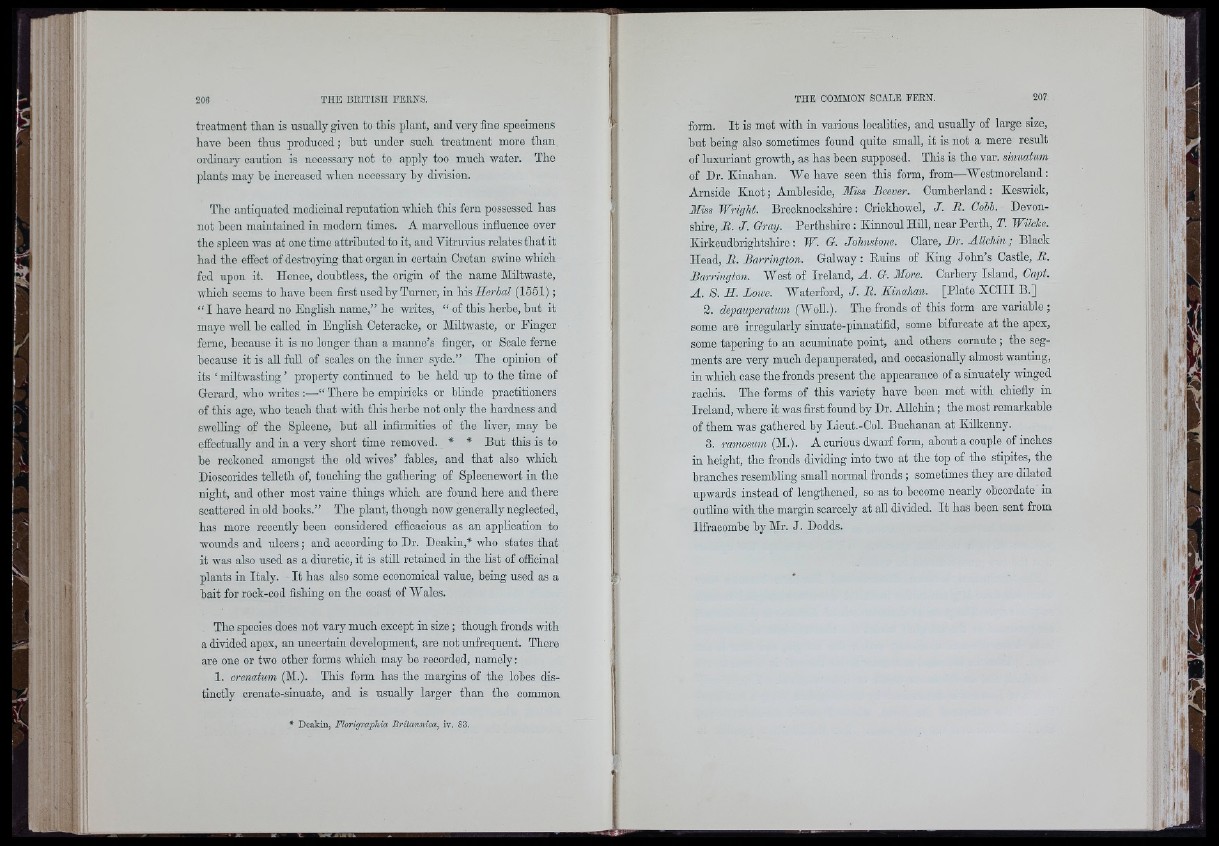
treatment than is usually given to this plant, and very fine specimens
have been thus produced; hut under such treatment more than
ordinary caution is necessary not to apply too much water. The
plants may be increased when necessary by division.
Tho antiquated medicinal reputation which this forn possessed has
not boon maintained in modern times. A marvellous influonoo over
the spleen was at one time attributed to it, and Vitruvius relates that it
had the effect of destroying that organ in certain Cretan swine which
fed upon it. Honoo, doubtless, tho origin of the name Miltwaste,
which seems to have been first used by Turner, in hki Herbal (1551);
“ I have hoard no English name,” ho writes, “ of this herhe, hut it
maye woll he called in English Ceteracke, or Miltwaste, or Finger
feme, because it is no longer than a maniie’s finger, or Scale feme
because it is all full of scales on the inner syde.” The opinion of
its ‘ miltwasting ’ property continued to he hold up to the time of
Gerard, who writes :—“ There he ompirioks or blindo practitioners
of this ago, who teach that with this herbe not only the hardness and
swelling of the Splecne, hut all infirmities of the liver, may he
offootually and in a very short time removed. * * But this is to
be reckoned amongst the old wives’ fables, and that also which
Dioscorides telleth of, touching the gathering of Spleenewort in the
night, and other most vaine things which are found here and there
scattered in old books.” The plant, though now generally neglected,
has more recently been considered efficacious as an application to
wounds and ulcers; and according to Dr. Deakin,* who states that
it was also used as a diuretic, it is still retained in the list of officinal
plants in Italy. It has also some economical value, heing used as a
bait for rock-ood fishing on the coast of Wales.
The species does not vary much except in size; though fronds with
a divided apex, an uncertain development, are not unfrequent. There
are one or two other forms which may be recorded, namely:
1. crenatum (M.). This form has the margins of the lobes distinctly
crenate-sinuate, and is usually larger than the common
* Deakiu, Florigraplivx. Brita n n im , iv. 83.
>iS
form. It is met with in various localities, and usually of large size,
but being also sometimes found quite small, it is not a mere result
of luxuriant growth, as has been supposed. This is the var. sinuatum
of Dr. Kinahan. We have seen this form, from—Westmoreland:
Arnside Knot; Ambleside, Miss Beever. Cumberland; Keswick,
Müs Wright. Brecknockshire: Criokhowel, J. JR. Cobb. Devonshire,
B. J. Gray. Perthshire : Kinnoul Hill, near Perth, T. Wilcke.
Kirkcudbrightshire: W. G. Johnstone. C\axe, Dr. Allchin; Black
Head, B. Barrington. Galway : Euins of King John’s Castle, B.
Barrington. West of Ireland, A. G. More. Carhory Island, Capt.
A . 8. H. Lowe. Waterford, J. B. Kinahan. [Plate XCIII B.]
2. depauperatum (Woll.). The fronds of this form are variable ;
some are irregularly sinuate-pinnatifid, some bifurcate at tho apex,
some tapering to an acuminate point, and others cornute ; the segments
are very much depauperated, and occasionally almost wanting,
in which case tho fronds present the appearance of a sinuately mnged
rachis. The forms of this variety have been met with chiefly in
Ireland, where it wms first found by Dr. Allchin; the most remarkable
of them was gathered by Liout.-Col. Buchanan at Kilkenny.
3. ramosum (M.). A curious dwarf form, about a couple of inches
in height, the fronds dividing into two at the top of the stipites, the
branches resembling small normal fronds ; sometimes they are dilated
upwards instead of lengthened, so as to become nearly obcordate in
outline with the margin soaroely at all divided. It has been sent from
Ilfraoombe by Mr. J. Dodds.
I. II
V fj
i ,
A ' 'i:|
i l i
r j
#1
(
‘'*1
: I 'i
'ii'n
I
Ii i l i t